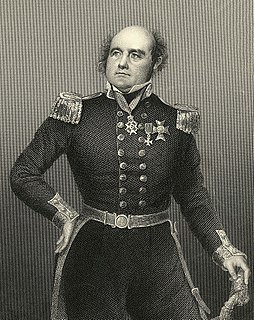
Rear-Admiral Sir John Franklin was a British Royal Navy officer and Arctic explorer. After serving in wars against Napoleonic France and the United States, he led two expeditions into the Canadian Arctic and through the islands of the Arctic Archipelago, in 1819 and 1825, and served as Lieutenant-Governor of Van Diemen's Land from 1839 to 1843. During his third and final expedition, an attempt to traverse the Northwest Passage in 1845, Franklin's ships became icebound off King William Island in what is now Nunavut, where he died in June 1847. The icebound ships were abandoned ten months later and the entire crew died, from causes such as starvation, hypothermia, and scurvy.

HMS Resolute was a mid-19th-century barque-rigged ship of the British Royal Navy, specially outfitted for Arctic exploration. Resolute became trapped in the ice and was abandoned in 1854. Recovered by an American whaler, she was returned to Queen Victoria in 1856. Timbers from the ship were later used to construct the Resolute desk which was presented to the President of the United States and is currently located in the White House Oval Office.
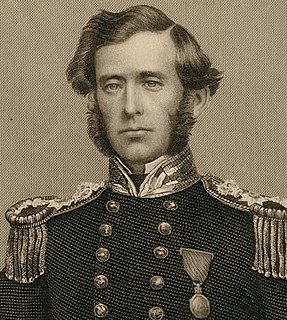
Sir Francis Leopold McClintock was an Irish explorer in the British Royal Navy, known for his discoveries in the Canadian Arctic Archipelago. He confirmed explorer John Rae's controversial report gathered from Inuit sources on the fate of Franklin's lost expedition, the ill-fated Royal Navy undertaking commanded by Sir John Franklin in 1845 attempting to be the first to traverse the Northwest Passage.

Joseph-René Bellot was a French naval officer and Arctic explorer.

Elisha Kent Kane was an American explorer, and a medical officer in the United States Navy during the first half of the 19th century. He was a member of two Arctic expeditions to rescue the explorer Sir John Franklin.

Sir Horatio Thomas Austin was a British Royal Navy officer and explorer.

Sherard Osborn was a Royal Navy admiral and Arctic explorer.
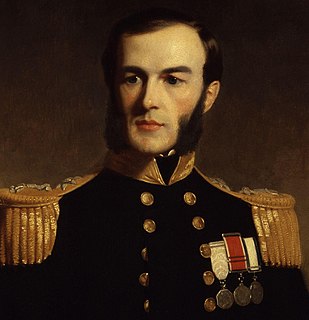
Admiral Sir Edward Augustus Inglefield was a Royal Navy officer who led one of the searches for the missing Arctic explorer John Franklin during the 1850s. In doing so, his expedition charted previously unexplored areas along the northern Canadian coastline, including Baffin Bay, Smith Sound and Lancaster Sound.

Admiral Sir Richard Collinson was an English naval officer and explorer of the Northwest Passage.

Jane, Lady Franklin was the second wife of the English explorer Sir John Franklin. During her husband's period as Lieutenant-Governor of Van Diemen's Land, she became known for her philanthropic work and her travels throughout south-eastern Australia. After John Franklin's disappearance in search of the Northwest Passage, she sponsored or otherwise supported several expeditions to determine his fate.
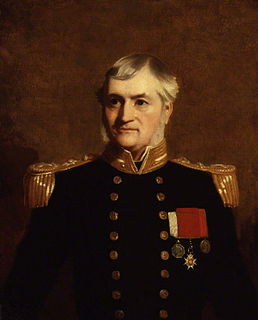
Vice Admiral Sir Henry Kellett, was a British naval officer and explorer.

Franklin's lost expedition was a failed British voyage of Arctic exploration led by Captain Sir John Franklin that departed England in 1845 aboard two ships, HMS Erebus and HMS Terror, and was assigned to traverse the last unnavigated sections of the Northwest Passage in the Canadian Arctic and to record magnetic data to help determine whether a better understanding could aid navigation. The expedition met with disaster after both ships and their crews, a total of 129 officers and men, became icebound in Victoria Strait near King William Island in what is today the Canadian territory of Nunavut. After being icebound for more than a year Erebus and Terror were abandoned in April 1848, by which point Franklin and nearly two dozen others had died. The survivors, now led by Franklin's second-in-command, Francis Crozier, and Erebus's captain, James Fitzjames, set out for the Canadian mainland and disappeared having presumably perished.
William Parker Snow (1817–1895) was a minor Arctic explorer, writer and mariner.
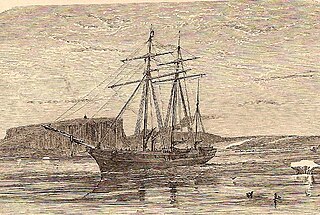
The Fox was an 1854 steam yacht commanded by Leopold McClintock on a privately funded 1857–1859 expedition to the North American Arctic Archipelago to search for clues about the fate of Franklin's lost expedition.

William Kennedy was a Canadian fur trader, politician, and historian.
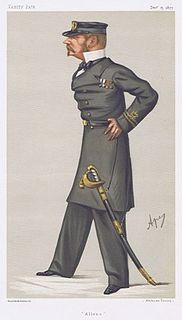
Sir Allen William Young, was an English master mariner and explorer, best remembered for his role in Arctic exploration including the search for Sir John Franklin.
The First Grinnell expedition of 1850 was the first American effort, financed by Henry Grinnell, to determine the fate of the lost Franklin Northwest Passage expedition. Led by Lieutenant Edwin De Haven, the team explored the accessible areas along Franklin's proposed route. In coordination with British expeditions, they identified the remains of Franklin's Beechey Island winter camp, providing the first solid clues to Franklin's activities during the winter of 1845, before becoming icebound themselves.

Thomas Abernethy was a Scottish seafarer, gunner in the Royal Navy, and polar explorer. Because he was neither an officer nor a gentleman, he was little mentioned in the books written by the leaders of the expeditions he went on, but was praised in what was written. In 1857, he was awarded the Arctic Medal for his service as an able seaman on the 1824–25 voyage of HMS Hecla, the first of his five expeditions for which participants were eligible for the award. He was in parties that, for their time, reached the furthest north, the furthest south (twice), and the nearest to the South Magnetic Pole. In 1831, along with James Clark Ross's team of six, Abernethy was in the first party ever to reach the North Magnetic Pole.
Robert Anstruther Goodsir was a Scottish doctor, explorer and writer. He made two voyages to the Arctic in search of his brother Harry Goodsir who was lost with the Franklin expedition.

HMS Desperate was originally slated to be built to the Sampson designed steam vessel rated as a Steam Vessel First Class (SV1); however, the Admiralty, first rerated the vessels as First Class Sloops on 19 April 1845 then on the 9 May 1845, she was ordered as First-Class screw sloops to be built from a design of Sir William Symonds, Surveyor of the Navy. She would be a 10-gun vessel with 400 NHP engines. She served in the Baltic during the Crimean war, and as a store ship to Edward Augustus Inglefield's Arctic expedition. She was broken up by 1865.


















